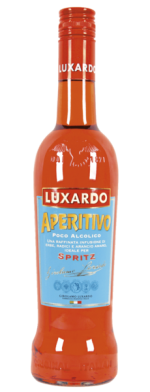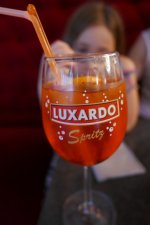andynap
Senior Insider
[h=1]Aperol Spritz[/h] Makes 1 cocktail
2 ounces Aperol
3 ounces Prosecco
Splash of soda water
Half an orange slice
Fill a wineglass half-full of ice. Add Aperol, then Prosecco. Top with a splash of sparkling water, stir, and then drop in an orange slice.
 Sgroppino (from left), Negroni, Aperol Spritz. STEVEN M. FALK
Sgroppino (from left), Negroni, Aperol Spritz. STEVEN M. FALK
[h=1]Americano Perfecto[/h] Makes 1 cocktail
1 1/2 ounces Campari
3/4 ounce Dolin Rouge
3/4 ounce Carpano Antica
4 ounces pilsner
orange wheel
1. Pour Campari and vermouths into a Collins glass over ice.
2. Top with pilsner and garnish with orange. — Damon Boelte, from Spritz: Italy’s Most Iconic Aperitivo Cocktail, by Talia Baiocchi and Leslie Pariseu
Note: This is Boelte’s twist on the Americano, a classic aperitivo. For the traditional version, pour 1 1/2 ounces Campari and 1 1/2 ounces sweet vermouth into a Collins glass over ice, top with soda water, and garnish with an orange wheel.
[h=1]Campari Spritz[/h] Makes 1 cocktail
1 1/2 ounces dry white wine
1 ounce Campari
1/2 ounce soda water
1 orange slice
1 green olive (optional)
1. Fill a rocks glass with 3 or 4 ice cubes. Add the white wine, Campari, and soda water.
2. Stir with a bar spoon, then add the orange slice and an olive on a cocktail skewer. — Marisa Huff, Aperitivo: The Cocktail Culture of Italy
Note: Easy variations include Aperol Spritz (replace the Campari with Aperol) and Spritz Bianco (equal parts white wine and soda, with a lemon garnish and no liqueur or olive
2 ounces Aperol
3 ounces Prosecco
Splash of soda water
Half an orange slice
Fill a wineglass half-full of ice. Add Aperol, then Prosecco. Top with a splash of sparkling water, stir, and then drop in an orange slice.

[h=1]Americano Perfecto[/h] Makes 1 cocktail
1 1/2 ounces Campari
3/4 ounce Dolin Rouge
3/4 ounce Carpano Antica
4 ounces pilsner
orange wheel
1. Pour Campari and vermouths into a Collins glass over ice.
2. Top with pilsner and garnish with orange. — Damon Boelte, from Spritz: Italy’s Most Iconic Aperitivo Cocktail, by Talia Baiocchi and Leslie Pariseu
Note: This is Boelte’s twist on the Americano, a classic aperitivo. For the traditional version, pour 1 1/2 ounces Campari and 1 1/2 ounces sweet vermouth into a Collins glass over ice, top with soda water, and garnish with an orange wheel.
[h=1]Campari Spritz[/h] Makes 1 cocktail
1 1/2 ounces dry white wine
1 ounce Campari
1/2 ounce soda water
1 orange slice
1 green olive (optional)
1. Fill a rocks glass with 3 or 4 ice cubes. Add the white wine, Campari, and soda water.
2. Stir with a bar spoon, then add the orange slice and an olive on a cocktail skewer. — Marisa Huff, Aperitivo: The Cocktail Culture of Italy
Note: Easy variations include Aperol Spritz (replace the Campari with Aperol) and Spritz Bianco (equal parts white wine and soda, with a lemon garnish and no liqueur or olive









